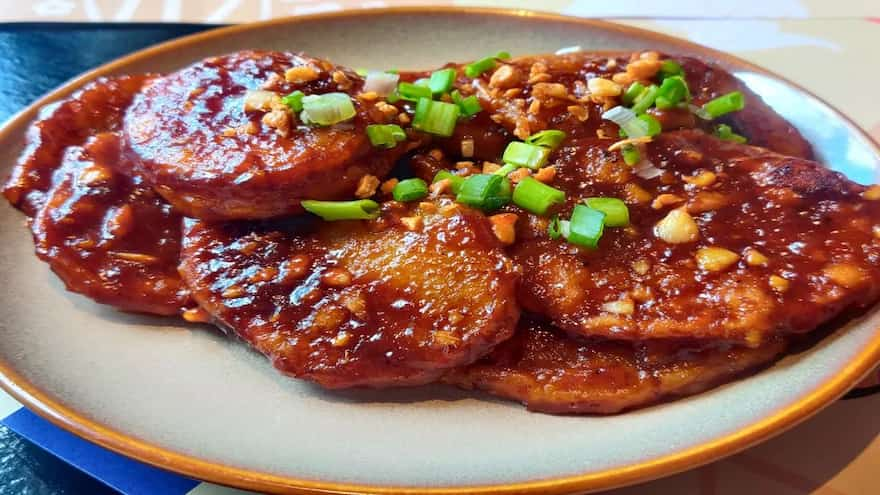Remember when all of us danced to the tunes of Gangnam style? That was perhaps our first yet most lasting impression of Korean culture. Now, it wouldn't be an exaggeration to say that the world is under the K influence, from beauty, K Pop to Korean Drama. The latest craze among people is Korean food. And such popularity of K-Culture is rapidly rising in the Indian City of Pearls, Hyderabad. It has become a driving factor for the Hyderabadi foodies to explore this cuisine. Reading the pulses of the epicureans, an exclusive and elaborate Mani Mogo – The Korean brunch now hits the city's food scene. Launched at Zega, Sheraton Hotel, Hyderabad, the Sunday brunch is a perfect getaway to give your palate a dose of this exquisite cuisine.
As a fan of Korean drama, I thought of trying this food. So, I headed to Zega, located on the tenth floor of the hotel in Gachibowli. The interior of this eatery has a dominance of black hues adding richness to the aesthetics. Why Korean in a city which is famed for Biryani and kebabs? "When people talk about the pan Asian cuisine, the Korean food doesn't get recognition. It has its own imposing identity. The cuisine derives influence from Japanese and Chinese food, yet retains its signature taste," mentioned the F&B staff. By serving some of the most well-liked items, this brunch strives to assuage cravings. A selection of specialities is on the offing, including Bibimbap (mixed rice), Gimbap (Korean sushi), Tteokbokki (spicy stir-fried rice), Japchae (sweet potato glass noodles), and Kkwabaegi (twisted cinnamon doughnuts), await to take you on a tour of this country's fare.
Though traditionally, Koreans eat everything together, unlike the course-based meal of dining of the west; this brunch serves the dishes in a course manner. First arrives a refreshing welcome drink in a shot glass.

Welcome drink and three kimchis
It is followed by three types of kimchi, i.e., Nappa Cabbage Kimchi, Radish Kimchi, and Cucumber Kimchi. These kimchis are quite different in taste from what we get in most restaurants. They are a tad fiery and have no sweetness. I was told that the original kimchi preparation is a lengthy and slow fermentation process. Sadly, many eateries use vinegar for a quick fix, which isn't the authentic process.
Next appeared Kimbap/Gimbap, which shares similarities in looks with sushi but isn't one. It is Korean sticky rice rolls with a lot of stuffing inside. I opted for the vegetarian Gimbap, which had cabbage, carrots, and other vegetarian stuffing. The non-vegetarian variant has carrot, scallion, takuan, spinach, and egg.

Veg-Gimbap
The third dish on the table was soup. One can opt for Dak Gomtang or Korean Chicken and Rice Soup, Dak Kalguks or Korean Chicken Noodle Soup. There is also Kalguksu and Tteokguk. Although I chose a vegetarian noodle soup, the use of seaweed suffused an evident fish smell. The appetisers section has two options to choose from, and the dishes on the menu are Bulgogi, Marinated Beef/Chicken Barbecue, Haemul Pajeon, Seafood and Scallion Pancake, Dakgangjeong or Chicken Morsels Tossed with Gochujang Sauce.

Potato starter
The fourth one to make its entry on the table was a potato-based starter; it had a sweet and spicy taste and reminded me of the taste of Manchuria. One can select two main course options: Dakdoritang or Spicy Korean chicken stew with potato, Dakgalbl or spicy Korean chicken stir-fry, Maeuntang or spicy Korean fish stew with radish and Gochujang, Achobak-Saeu-Bokkeum stir-fry zucchini and prawns. Likewise, there is an option for any two rice or noodles preparations. Bibimbap or mixed rice with vegetables, Japcha or wok-tossed soft potato noodles with vegetables, Jajangmyeon or black bean noodle vegetables, Kimchi Bokkeum Bap or kimchi fried rice vegetables.

Kkwabaegi, Image Source: Zega
Though Koreans aren't much dessert lovers, as I was informed, I loved both the desserts here, i.e., Yakwa or Korean honey pastry and Kkwabaegi or Korean doughnuts. The former is a painstakingly made dessert with rice flour, all flour, chopped nuts (pinenuts) and kneaded into a dough. Then, small oval shape balls are handcrafted, slow fried in oil, and soaked in honey, corn syrup ginger overnight. The right proportion of the ingredients and cooking time are important to ace this difficult to make sweetmeat.
Chef Benjamin Lalhmangaiha, who curated the entire menu, shared that sourcing the ingredients took almost a month, as these aren't locally available. Without a few of them, it is impossible to create the authentic flavour of Korean food. However, as the locals might detest fish oil, it is not used. So, rest assured that even if this is your first time experiencing it, the food's carefully selected flavour profile will satisfy even the pickiest Indian taste buds.
Now experience the Korean flavours in Hyderabad with Mani Mogo every Sunday from 12:30 -3:30 pm.


